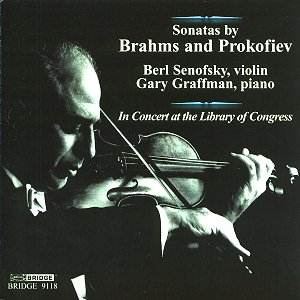Berl Senofsky, who died very recently, was born in
Philadelphia in 1925. Of Russian émigré stock – his father
had studied with Leopold Auer – Senofsky studied with the dean of American
teachers, Louis Persinger, and subsequently with Ivan Galamian at Juilliard.
He came from a remarkable generation of American born players – his
contemporaries included Oscar Shumsky, Sidney Harth, Aaron Rosand, David
Nadien and the slightly younger Joseph Silverstein. Between 1950 and
1955 he was Assistant Concertmaster of the Cleveland Orchestra under
George Szell. Next to him in the leader’s chair sat Joseph Gingold.
Senofsky sensationally became the first American winner of the Queen
Elizabeth Violin Competition in Brussels – beating, in the terminology
of such things, no less than the superb Russian player Julian Sitkovetsky
as well as such well-known violinists as Viktor Pikaisen and Alberto
Lysy. He began to appear with leading orchestras, toured the Walton
Concerto with the composer conducting during an extensive Australasian
tour – a superbly deadpan colour photograph of the two men arm in arm,
encumbered with pipes, is reproduced in the booklet – and a strong career
beckoned. Somehow it never quite happened for Senofsky despite a few
discographic triumphs. The Brahms Concerto with the Vienna Symphony
under Moralt on Epic both underlined his solid position on the European
continent and ironically reflected the pattern of an earlier recording
of another leading American player, Albert Spalding, who had, towards
the end of his career, also recorded Brahms in Vienna.
With Graffman, his partner at this Library of Congress
recital and whom he’d met first in 1952, he set down the Brahms Op 87
Trio and Beethoven Kakadu Variations – with cellist Shirley Trepel –
in 1965, in addition to their earlier 1961 disc pairing the Debussy
Sonata of 1917 and the Fauré No 1. Elsewhere he appears but rarely
on disc, emphasising the importance of this 1975 survival. He did record
the Brahms No2 and Strauss - with Vanden Eynden on Phonic, as well as
sonatas by Branco and Goldman but these were on obscure labels and all
but invisible. Currently some CDs on the Cembal d’amour label are devoted
to off-air performances and a tape of his prize winning 1955 Queen Elizabeth
Debussy has circulated. In his later years he turned more and more to
chamber music and to teaching – he was at Peabody for many years and
a greatly admired figure.
For the Brahms Sonata, rather airlessly recorded, the
two men begin in appropriately interior fashion; their ensemble is good,
with Graffman perhaps a little too prominent in the balance. This is
a relaxed and unhurried interpretation with Serofsy’s trademark fast
vibrato prominent. In the first movement there are moments when he sounds
as if he is having some problems with his right arm and whilst his attacks
and accents are bold and strong they can also coarsen somewhat under
pressure. The second subject of the slow movement is very deliberately
phrased with Graffman italicising the piano writing rather too broadly
for my liking and Senofsky, though a tonalist of distinction, can be
rather portly and stolid in passagework. He certainly doesn’t convince
me at this somewhat distended tempo and whilst his lyric intensity can’t
be doubted the ardour is rather hobbled here. He commands a wide range
of shadings and colours even with his fast vibrato – an idiosyncratic
one not always easily suited to romantic music – and in the finale employs
some succulent intensification but whilst the depth of tone he elicits
is good there is a real lack of necessary momentum from both men that,
for me, sabotages the performance.
The Prokofiev is rather better. Graffman is idiomatic
and technically adroit infusing his part with manifold skill and insight.
The opening Andante assai sees Senofsky poised and vigorous with no
loss of subtlety. He is powerfully energised in the fiendish Allegro
brusco second movement, a few patchy moments apart – especially expressive
from 5.50 and in the slow movement Senofsky, muted, whilst hardly a
match for Oistrakh, exemplifies why he was so admired with some burnished
playing. Their ensemble, with those tempting, teasing accents and rhythmic
dislocations in the Allegrissimo, survives scrutiny – Graffman releasing
left hand accents with insouciant address. As the movement draws to
a close Senofsky’s vibrato becomes more problematically oscillatory
but it is attractively scaled and a worthy reminder of his art.
The disc concludes with a stage-announced performance
of Brahms’s Sonatensatz, a good performance. Altogether this is an admirable
tribute to a fine violinist. With Graffman he had a collaborator of
instinctual understanding and if neither of the major performances are
world shattering they still shed serious light on Senofsky’s artistic
profile and that is entirely right and proper.
Jonathan Woolf


